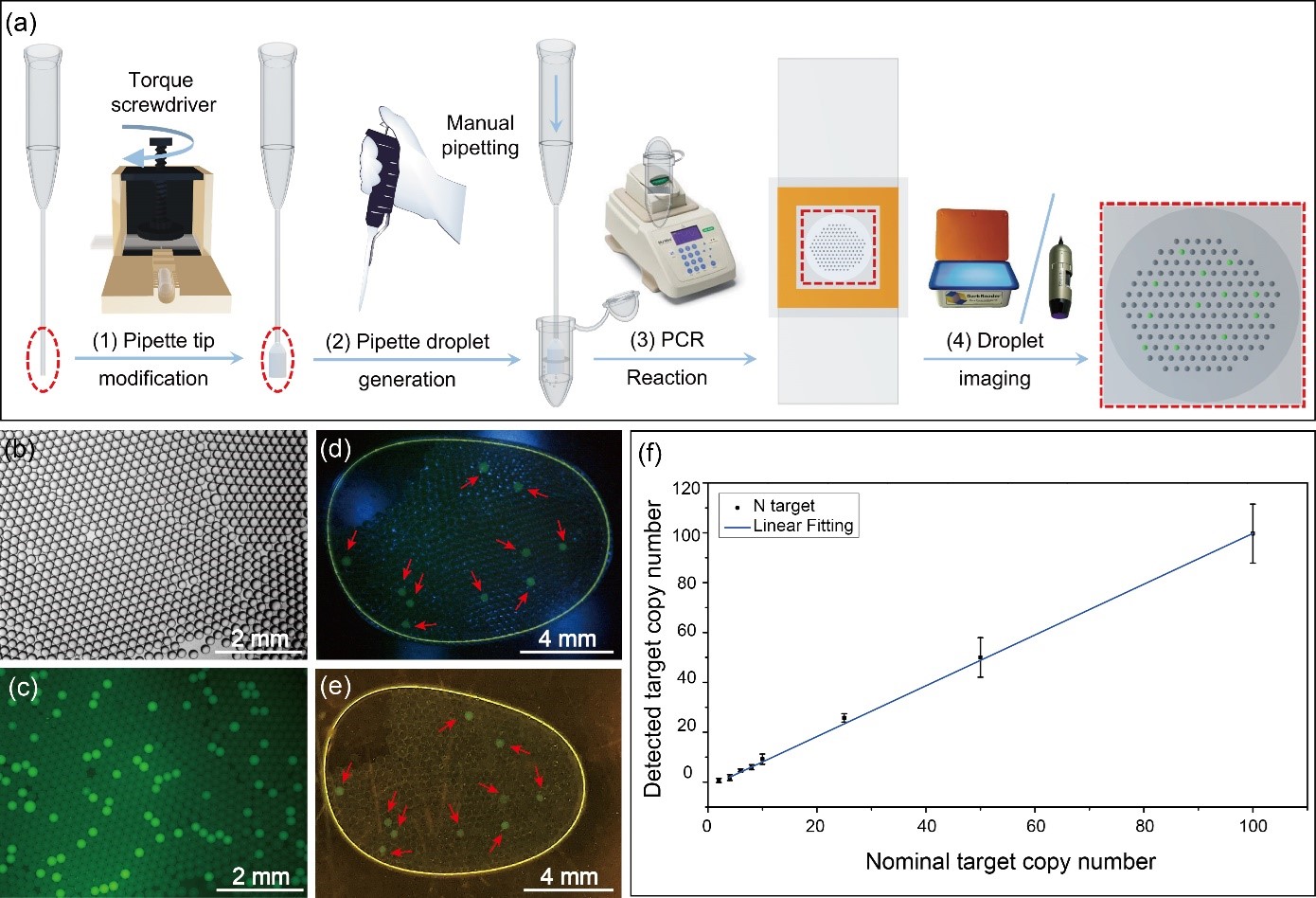Pipette droplet digital polymerase chain reaction (PddPCR)

We have developed a point-of-need cost-effective kit to conduct ddPCR in resource-limited settings without expensive instruments. Thousands of uniform microdroplets are generated by manual pipetting of liquid reaction mix out from pipette tips with elliptical orifices. Rapid droplet pinch-off by the dripping mechanism is driven by the higher azimuthal curvature of the elliptical cross-section, which is significantly higher than the stabilizing axial curvature. The elliptical pipette tips are customized by deforming commercial round-orifice pipette tips with a torque screwdriver tool. The droplets are stabilized by a new hybrid surfactant system for robust PCR thermal cycling in regular PCR tubes by a portable thermal cycler. After cycling, the droplets are immobilized in the shallow center of an easily fabricated tape-based chip for imaging by a smartphone camera or a handheld mini-microscope. Extremely low Limit-of-Detection (~ 5 copies of SARS-CoV-2 RNA in a typical sample) is achieved, comparable to high-end commercial products. We are currently working on the extension of this pddPCR technology to single exosome analysis and profiling of a panel of miRNA.
Immersed AC Electrospray (iACE)

We invented a new immersed AC Electrospray droplet generation method that can generate monodispersed water-in-oil droplets, with diameters ranging from 5 μm to 150 μm, in a stationary oil phase. This method offers high through-put, easy size tuning and droplets with a viscous aqueous phase at high ionic strengths (raw physiological samples). Yet it does not require coordinated flows of the dispersed/continuous phases or even a microfluidic chip. The design relies on a small constant back pressure (less than 0.1 atm) to drive the water phase through a nozzle (glass micropipette) and a non-isotropic AC electric Maxwell pressure to eject it into the oil phase. Undesirable field-induced discharge and nanojet formation at the tip are suppressed with a biocompatible polymer, polyethylene oxide (PEO) . Its viscoelastic property favors the monodispersed dripping mechanism, with a distinct neck forming at the capillary tip before pinch-off, such that the tip dimension is the only controlling length scale. Consecutive droplets are connected by a whipping filament that disperses the drops away from the high-field nozzle to prevent electro-coalescence. A scaling theory is developed to correlate the droplet size to the applied pressure, the most important tuning parameter, and to determine the optimum frequency. The potential applications of this technology to biological systems is demonstrated with a digital loop-mediated isothermal amplification experiment, with little damage to the nucleic acids and other biomolecules, but with easy adaptive tuning for the optimum droplet number for accurate quantification.
Digital loop-mediated amplification (dLAMP)

Loop-mediated isothermal amplification (LAMP) is increasingly being used in point-of-care applications such as virus detection due to its constant reaction temperature, high specificity and sensitivity. To demonstrate the utility of iACE, we performed absolute nucleic acid quantification using digital loop-mediated isothermal amplification (digital LAMP) on lambda DNA as a model system. Other than demonstrating the viability of our droplet generation technology for LAMP--that the AC field does not degrade the molecular analytes and reagents, our new droplet generation technology also offers a major advantage for digital droplet PCR and LAMP. Digital PCR is often used for absolute quantification of specific DNA (and to a lesser degree RNA) copy number. Quite often, the pathogen number (and hence the copy number of their genomic DNA or RNA) in physiological samples can vary over a large dynamic range (six orders of magnitude). To get accurate quantification, the number of droplets need to be adjusted so it is roughly at least one fifth of the copy number. As the sample volume remains the same, this requires iterations on the droplet size. The fact that our droplet generation technology allows easy adjustment of droplet size will greatly simplify this adaptive iteration process.